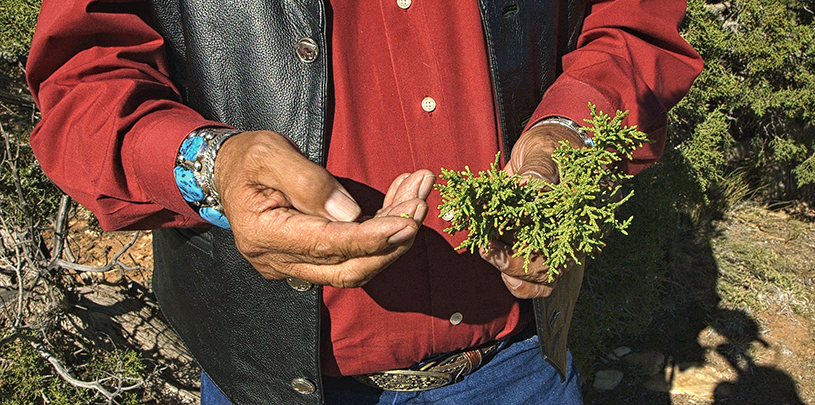
 by Kamran Zafar, Field Attorney
by Kamran Zafar, Field Attorney
If you’ve ever visited the Southwest, you’ve probably walked or driven through pinyon and juniper forests. From Mesa Verde National Park and Grand Staircase-Escalante National Monument to Cibola National Forest and the Grand Canyon, pinyon and juniper are quintessential to the Colorado Plateau. The stubby, gnarled trees survive in the extremes that characterize the region — brutal heat, bitter cold, and a characteristic lack of water. Just as pinyon and juniper adapted to life on the plateau, Indigenous peoples of the Southwest adapted to life with the constant presence of the trees.
Rooted in survival and ceremony, cultural uses of pinyon and juniper for the Diné, Hopi, Paiute, Ute, and other Native peoples range from food and medicine to firewood and art. The importance of the trees goes far beyond calories, warmth, and shelter, though. To Indigenous peoples, pinyon and juniper represent a way of life — a long-standing connection to the land — that continues to this day.

Pine nuts — the buttery morsels hidden in pine cones — have been a staple for Native peoples for thousands of years. Historically, Native peoples ate the raw nuts, ground them into a pine nut flour, made pine nut butter, or used them in soups. Cultural uses remain similar today, and the annual fall harvest of pine nuts is an important social and ceremonial tradition.
Native peoples also enjoy the small, bluish juniper “berries” — technically cones — baked in bread, steeped in tea, stewed with meats, raw, or roasted.
Additionally, pinyon and juniper woodlands support a variety of game animals. Antelope, elk, deer, turkey, rabbit, quail, pigeon, and more attracted Native peoples to inhabit and hunt in these woodlands.
(Photo: Karlos Baca, chef and founder of Taste of Native Cuisine. ELIZABETH HOOVER.)
Pinyon and juniper trees are part of a natural pharmacy. Clyde Benally, a Diné elder, historian, scholar, and Mesa Verde National Park ranger, says Diné people often burn juniper bark and add the ashes to blue corn mix. “When you add the ashes, you are not only adding flavor and nutrients to the food. You are adding the healing powers of the juniper to the food. You are consuming and adding the trees' powers to yourself.”
Juniper berries cure influenza, fight dandruff, treat indigestion, and soothe aches and pains. Juniper leaves brewed into a tea can induce pregnancy.
Pinyon pitch — the almost crystallized, sap-like substance — is used in salves for open cuts and sunburns, and is ground into powder as an antiseptic for wounds. It is also used to fill cavities in aching teeth. Some Native peoples even used the powder from rotted pinyon wood as a substitute for baby powder.
Benally, says that in Diné tradition, one must go through a three-day-long ceremony in order to receive blessings to remove a plant for medicinal or ceremonial use. He says you must make an offering to take a plant’s power for yourself, because a plant’s power is to be respected and not taken lightly.
Wood from pinyon and juniper trees, as you might guess, proves valuable as a raw material for construction projects. It's used to build fences, corrals, cradles, agricultural equipment, and roofs. Wood also makes useful household tools, like ladles and hairbrushes, and weapons, such as bows and clubs. Beyond utilitarian needs, juniper seeds are the perfect beads for jewelry, and the berries stain pottery and skins. Pinyon pitch, due to its sticky nature, waterproofs items like canoes and pottery and helps cement turquoise and other gems into jewelry.

Much depends on the health of pinyon and juniper forests — the culture and traditions of Native peoples, the future existence of key wildlife and plant species, and the health of our climate. For decades now, the Bureau of Land Management has moved forward with efforts to clear pinyon and juniper forests. In reality, these "vegetation projects" often turn forests into grazing lands as machines rip out, mow down, and shred pinyon and juniper trees. Within the original borders of Grand Staircase-Escalante National Monument, the BLM had proposed the removal of over 100,000 acres of pinyon and juniper woodlands.
READ MORE: Interior Board Overturns BLM Decision in Victory for Grand Staircase Forests ›
Karlos Baca (Tewa, Diné, and Nuu-ciu), a renowned chef and founder of Taste of Native Cuisine, says the problem with these vegetation treatments is that “the federal government does not understand symbiosis and the relationships between plants and the land.”
Take the Four Corners potato, possibly North America’s first cultivated plant, for example. According to Baca, it only grows in pinyon, juniper, and oak forests on the Colorado Plateau and has been used by Indigenous peoples for thousands of years. Messing with pinyon and juniper forests could risk the 11,000-year history of the Four Corners potato.
The Grand Canyon Trust remains committed and stands ready to call out and challenge the BLM and other federal agencies when they pursue these damaging projects.
“Everything is related, and all is needed. I understand this because I grew up here and have foraged in these lands my entire life,” says Baca.
We must all work to protect and conserve the precious pinyon and juniper forests of the Colorado Plateau so that they may continue existing beyond our time.
80% of Arizona voters support Baaj Nwaavjo I'tah Kukveni National Monument, according to a new poll.
Read MoreUtah voters strongly support national monuments in general, and Bears Ears and Grand Staircase-Escalante in particular, a new poll shows.
Read MoreA small victory in the legal case challenging Daneros uranium mine, near Bears Ears National Monument.
Read More